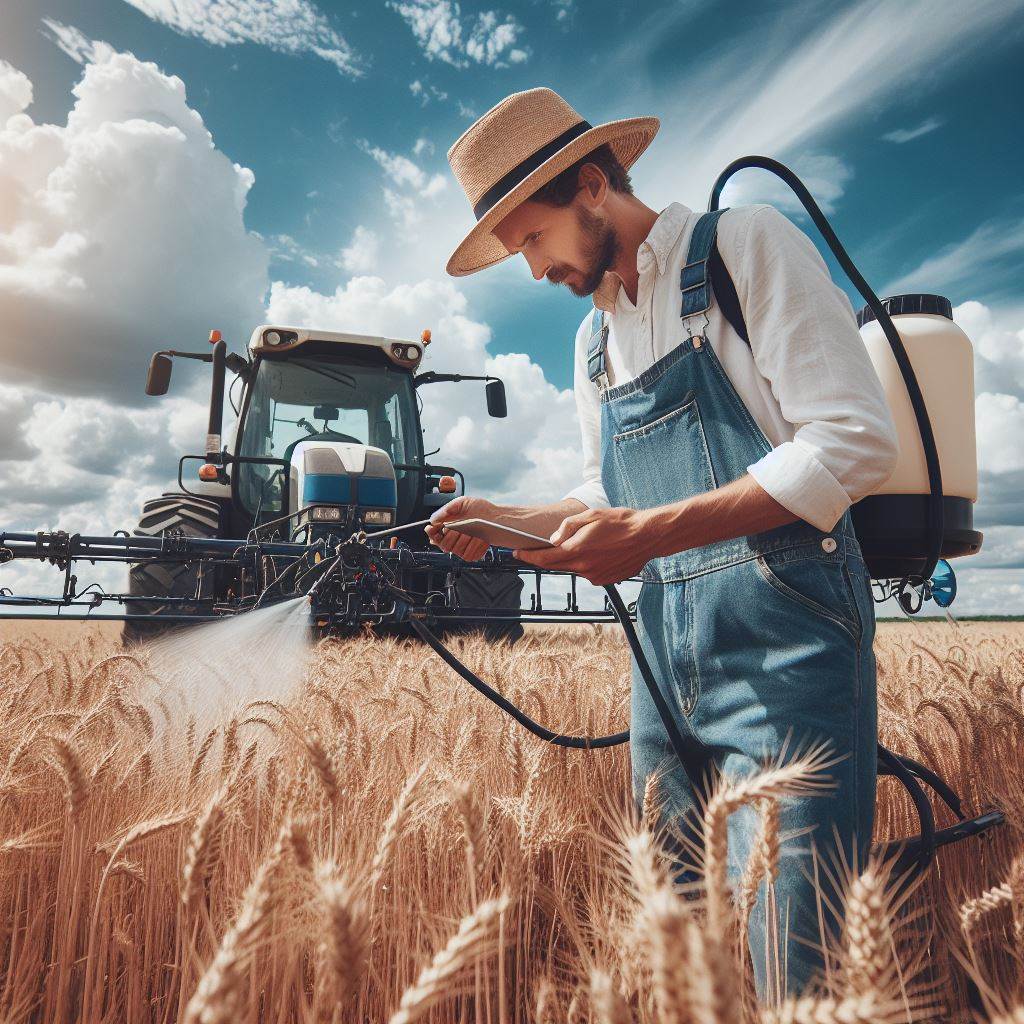Introduction
Sustainable pest control in urban farming aims to find environmentally friendly solutions to manage pests effectively.
Adopting sustainable methods is vital for maintaining the health of urban farms and protecting the surrounding ecosystem.
The purpose of this blog post is to explore the various sustainable pest control techniques used in urban farming.
In the bustling landscapes of urban environments, where concrete jungles meet slivers of green spaces, the pursuit of sustainable pest control within urban farms emerges as a crucial endeavor.
As these urban oases flourish amidst the backdrop of towering buildings and bustling streets, they face unique challenges in maintaining ecological balance and crop health.
In this intricate dance between nature and urbanization, the quest for sustainable pest control methods becomes not just a practical necessity but a testament to the harmonious coexistence of humans and the environment.
Join us on a journey through the intricacies of sustainable pest management within the vibrant tapestry of urban farming, where innovation, conservation, and community converge to cultivate a greener, healthier future for all.
Understanding Pest Control in Urban Farms
Urban farming and its significance
Urban farming refers to the cultivation of crops and the raising of animals in urban areas, such as cities and towns.
It is a practice that allows individuals and communities to grow their own food in limited spaces.
The significance of urban farming lies in its ability to promote self-sufficiency, increase access to fresh and nutritious food, and enhance local food security.
It also contributes to the development of sustainable and resilient cities, supporting environmental conservation and fostering community engagement.
Common pests faced in urban farms
Urban farms face a range of pests that can threaten crop yields and the overall success of farming operations.
Common pests include insects like aphids, caterpillars, and beetles that feed on plants and cause damage.
Rodents, such as mice and rats, are also frequent pests in urban farms. These creatures can damage crops, contaminate food, and spread diseases.
Additionally, birds may consume crops or cause damage through their nests.
Transform Your Agribusiness
Unlock your farm's potential with expert advice tailored to your needs. Get actionable steps that drive real results.
Get StartedThe challenges of pest control in urban settings
Pest control in urban settings presents unique challenges compared to rural or agricultural areas.
Limited space and proximity to human activity make traditional pest control methods, like chemical pesticides, less desirable due to potential health and environmental risks.
Furthermore, the diverse nature of urban ecosystems may make it difficult to target specific pests without harming beneficial organisms like bees or butterflies.
The presence of buildings, infrastructure, and other structures can also provide hiding places and pathways for pests, complicating control efforts.
To address these challenges, integrated pest management (IPM) approaches are crucial in urban farming.
IPM emphasizes the use of multiple strategies and techniques to prevent and manage pests effectively while minimizing environmental impact and promoting ecological balance.
Some IPM strategies used in urban farming include cultural control practices, such as crop rotation and intercropping, which disrupt pest life cycles.
Physical barriers, like nets or fences, can also protect crops from pest damage. Biological control methods, such as introducing predator insects, nematodes, or microbial agents, help keep pest populations in check.
Effective pest monitoring and early detection are essential components of urban farm pest control.
Regular inspections, use of traps, and scouting for signs of pest activity allow for timely intervention, preventing pest outbreaks and minimizing crop damage.
Moreover, education and community involvement play a vital role in sustainable pest control in urban farms.
By raising awareness about the importance of pest management and providing training on IPM techniques, urban farmers can empower themselves and their communities to address pest control challenges effectively.
In short, urban farming offers numerous benefits but also faces unique pest control challenges.
By understanding the significance of urban farming, recognizing common pests, and addressing the challenges through integrated pest management strategies, urban farmers can cultivate healthy and sustainable crops while minimizing the negative impacts of pests.
Read: Herb Gardening in Urban Environments
The Benefits of Sustainable Pest Control
In any agricultural system, pest control is a crucial aspect that directly affects the productivity and sustainability of urban farms.
Employing sustainable pest control methods offers a multitude of benefits for the environment, farmers, and consumers.
Environmental Benefits
Sustainable pest control methods prioritize the conservation of the environment.
Unlike conventional pest control approaches, sustainable methods do not harm non-target organisms, such as bees, butterflies, or birds.
By promoting biodiversity, these methods maintain the natural balance within urban farms, ensuring the presence of essential pollinators and beneficial insects like ladybugs, which control pest populations.
Moreover, reduced usage of harmful pesticides safeguards water sources and prevents pollution, contributing to a healthier ecosystem overall.
The adoption of sustainable pest control practices also minimizes the risk of chemical residues in food, offering safer and cleaner produce.
Health Benefits for Farmers and Consumers
Sustainable pest control practices significantly improve the health and well-being of farmers and consumers.
Farmers who practice sustainable pest control are less exposed to toxic chemicals, reducing the risk of pesticide poisoning and related health issues.
Showcase Your Farming Business
Publish your professional farming services profile on our blog for a one-time fee of $200 and reach a dedicated audience of farmers and agribusiness owners.
Publish Your ProfileIn the long term, this leads to improved overall health for farmers, ensuring their ability to continue farming sustainably.
Consumers also benefit from pesticide-free produce, as it decreases their exposure to potentially harmful chemicals.
Furthermore, sustainable pest control practices, often associated with organic farming, ensure the production of nutritious food, positively impacting consumers’ diets.
Reduced pesticide residues also make food safer, particularly for vulnerable populations such as children and pregnant women.
Economic Advantages of Adopting Sustainable Pest Control Practices
Beyond environmental and health benefits, sustainable pest control practices offer economic advantages for farmers.
These methods reduce farmers’ reliance on expensive pesticides, saving costs in the long term.
By closely monitoring pests, farmers can detect infestations at an early stage, preventing extensive crop damage.
Timely intervention ensures minimal losses and protects the economic viability of the farm.
Additionally, sustainable practices can lead to increased yields and improved crop quality, further benefiting the farmers financially.
Moreover, urban farms that adopt sustainable pest control practices enhance their reputation and marketability, catering to the growing demand for organic and sustainable produce.
Ultimately, by reducing input costs, farmers can achieve higher profitability and enhance their financial stability in the long run.
In fact, sustainable pest control methods in urban farms offer a range of benefits.
These practices contribute to a healthier environment by maintaining biodiversity and protecting water sources from pesticide pollution.
They also ensure the well-being of farmers and consumers, reducing exposure to toxic chemicals and providing safer and more nutritious food.
Additionally, sustainable pest control practices present economic advantages, including cost savings, increased yields, and improved marketability.
By adopting sustainable pest control methods, urban farmers play a crucial role in building a sustainable future for agriculture.
Read: Urban Farming for Schools and Communities
Sustainable Pest Control Strategies for Urban Farms
Pest control is a crucial aspect of urban farming, especially when aiming for sustainable and environmentally-friendly practices.
Traditional pest management techniques often rely on harmful chemical pesticides, which have adverse effects on human health and the surrounding ecosystem.
To maintain a sustainable pest control system in urban farms, alternative and organic methods should be adopted.
Organic pest management techniques
Crop rotation and companion planting
Crop rotation involves planting different crops in a specific sequence to reduce pest populations.
This technique disrupts pests’ breeding cycles and decreases population growth.
Companion planting involves growing mutually beneficial plants together, where certain plants repel pests or attract beneficial insects that prey on pests.
Attracting beneficial insects
Encouraging the presence of beneficial insects, such as ladybugs and lacewings, can help control pest populations naturally.
These insects act as natural predators and feed on pests that could potentially damage crops.
Planting flowers, especially those with nectar-rich blooms, can attract these beneficial insects to the farm.
Using natural repellents and barriers
Instead of chemical pesticides, urban farmers can use natural repellents like neem oil or garlic spray to deter pests.
These repellents create an unfavorable environment for pests without causing harm to beneficial insects or humans.
Additionally, physical barriers such as nets, screens, or row covers can protect crops from pests.
Integrated Pest Management (IPM) approach
Identifying pest populations and damage thresholds
Monitoring and identifying specific pest populations and the level of damage they cause is crucial in determining the appropriate pest control measures.
By setting damage thresholds, farmers can decide when it is necessary to intervene and implement control strategies.
Implementing cultural controls
Cultural controls involve practices that manage pests through altering the farm’s physical environment or cultural practices.
These include adjusting irrigation, implementing crop rotation, removing plant residues, and managing weeds effectively.
Such practices create unfavorable conditions for pests and reduce their ability to survive and reproduce.
Biological controls and biopesticides
Biological controls involve introducing natural enemies of pests, such as predatory insects, parasites, or pathogens, to suppress their populations.
Beneficial organisms like nematodes and certain fungi can also be used as biopesticides to control pests.
These methods harness nature’s own mechanisms to maintain a balance between pests and their predators.
Utilizing chemical controls as a last resort
Chemical controls should only be used as a last resort when all other methods have failed.
If non-chemical strategies are insufficient to manage pest populations, carefully selected pesticides should be applied according to specific pest infestations and with adherence to safety regulations.
Other sustainable practices
Proper sanitation and hygiene
Maintaining a clean and hygienic environment on the farm can significantly reduce pest infestations.
Showcase Your Farming Business
Publish your professional farming services profile on our blog for a one-time fee of $200 and reach a dedicated audience of farmers and agribusiness owners.
Publish Your ProfileRemoving plant debris, weeds, and other potential pest habitats can disrupt their lifecycle and discourage their presence.
Regular monitoring and scouting
Constant monitoring and scouting for pests allow farmers to identify problems early on and take immediate action.
Regular inspection of plants helps spot signs of infestations, enabling appropriate measures to be implemented promptly.
Educating farmers and the community
Education plays a vital role in promoting sustainable pest control practices.
By providing farmers and the surrounding community with knowledge about effective pest management techniques, they can actively participate in maintaining a balanced and healthy ecosystem.
By implementing organic pest management techniques, following the Integrated Pest Management approach, and adopting other sustainable practices, urban farmers can foster a harmonious relationship between their crops and the environment.
Sustainable pest control not only promotes the health and productivity of urban farms but also contributes to a healthier and more sustainable urban environment for all.
Read: Organic Urban Farming: Healthy City Life

Gain More Insights: Organic Farming: A Path to Sustainable Future
Case Studies: Successful Sustainable Pest Control in Urban Farms
Examples of urban farms effectively implementing sustainable pest control
Green Thumb City Farm in New York City
Green Thumb City Farm has successfully implemented sustainable pest control methods by using natural predators such as ladybugs and lacewings to control aphids.
Rooftop Gardens in Chicago
Rooftop Gardens in Chicago has effectively implemented sustainable pest control by practicing companion planting and using organic insecticides made from neem oil.
Urban Oasis Farm in San Francisco
Urban Oasis Farm has implemented sustainable pest control by creating a balanced ecosystem with the use of trap crops and beneficial insects.
Measurable outcomes and positive impacts achieved in these case studies
Green Thumb City Farm
The implementation of sustainable pest control methods has resulted in a significant reduction in aphid populations, leading to healthier plant growth and increased crop yields.
Rooftop Gardens
By practicing companion planting and using organic insecticides, Rooftop Gardens has seen a decrease in pest damage and an increase in the overall health and productivity of their crops.
Urban Oasis Farm
Through the use of trap crops and beneficial insects, Urban Oasis Farm has successfully minimized pest infestations, leading to improved crop quality and increased biodiversity on their farm.
In all these case studies, the implementation of sustainable pest control methods has not only reduced the reliance on chemical pesticides but also had several positive impacts:
- Reduced environmental contamination: By minimizing the use of chemical pesticides, these urban farms have contributed to reducing soil and water contamination, preserving the overall ecosystem.
- Promoted biodiversity: The use of natural predators and creating a balanced ecosystem has resulted in an increase in biodiversity, with a greater variety of plants, insects, and animals thriving in these urban farm environments.
- Improved food quality: The implementation of sustainable pest control methods has led to healthier and more nutritious crops, free from harmful pesticide residues, ensuring the delivery of safer and higher-quality produce to consumers.
- Community engagement: These successful case studies have also attracted attention and engagement from the local community, raising awareness about the importance of sustainable pest control in urban farming and inspiring others to follow suit.
- Economic benefits: By reducing the dependence on chemical pesticides, these urban farms have saved costs on purchasing and applying pesticides, leading to increased profitability and overall economic sustainability.
Overall, these case studies demonstrate the effectiveness of implementing sustainable pest control methods in urban farms.
By prioritizing ecological balance and minimizing harm to the environment and human health, these farms have achieved measurable positive impacts that extend beyond their immediate surroundings.
They serve as inspiring examples for other urban farms to adopt sustainable pest control practices and contribute to a greener and healthier urban agriculture system.
Read: Seasonal Urban Farming: Year-Round Tips
Overcoming Challenges and Limitations
Common challenges faced in implementing sustainable pest control in urban farms
- Limited space in urban farms often makes it challenging to implement sustainable pest control measures effectively.
- The proximity of urban farms to residential areas can impact the use of certain pest control methods due to safety concerns.
- Lack of knowledge and awareness about sustainable pest control practices among urban farmers can hinder implementation.
- High costs associated with sustainable pest control methods may pose a financial challenge for urban farmers.
Potential solutions and alternative approaches
- Utilize vertical gardening techniques to maximize space and reduce the risk of pest infestation.
- Implement integrated pest management (IPM) strategies that combine cultural, biological, and chemical controls.
- Encourage collaboration and knowledge sharing among urban farmers to improve awareness and adoption of sustainable pest control practices.
- Seek grants and funding opportunities to help urban farmers cover the costs of sustainable pest control methods.
Potential limitations and how to minimize their impact
- Limited availability of organic and non-toxic pest control products can be a limitation. Encourage the development and availability of more sustainable options.
- Weather conditions and environmental factors may affect the effectiveness of pest control methods. Regular monitoring and adaptation is crucial.
- Regulatory constraints and restrictions on certain pest control methods may limit the options available. Collaborate with local authorities to address these limitations.
- Scaling up sustainable pest control practices in urban farms may require additional resources and infrastructure. Advocate for government support and invest in necessary infrastructure.
By addressing the common challenges, offering alternative approaches, and minimizing limitations, urban farmers can successfully implement sustainable pest control methods in their farms.
With careful planning, collaboration, and resource allocation, urban farming can flourish while minimizing the ecological impact and ensuring a healthier environment for all.
Conclusion
In order to ensure the success and longevity of urban farming, it is crucial to prioritize sustainable pest control practices.
By doing so, farmers can maintain the health and productivity of their crops without causing harm to the environment or human health.
Implementing sustainable pest control methods, such as integrated pest management (IPM), reduces reliance on harmful chemical pesticides.
This promotes biodiversity and protects beneficial insects, which play a vital role in pollination and natural pest control.
Additionally, sustainable pest control in urban farming promotes the development of resilient farming systems.
By working with nature rather than against it, farmers can mitigate pest outbreaks and build resistance over time.
This reduces the need for costly and unsustainable interventions in the long run.
To ensure long-term success and sustainability, it is crucial for farmers to adopt these practices.
By prioritizing sustainable pest control, farmers can safeguard the health and productivity of their farms while also protecting the surrounding environment and community.
We encourage readers to further educate themselves on sustainable pest control methods and to support local initiatives that promote sustainable urban farming.
By doing so, we can all contribute to the growth of a more resilient and sustainable food system.
Together, let’s create a future where urban farming thrives in harmony with nature.




